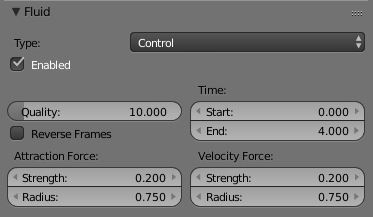Fluid Control¶
Using the Lattice-boltzman method, the fluid is controlled using particles which define local force fields and are generated automatically from either a physical simulation or a sequence of target shapes. At the same time, as much as possible of the natural fluid motion is preserved.
Options¶

Fluid control options.
- Enabled
- Controls weather the control object contributes to the fluid system. This is useful when animating the fluid control object.
- Quality
- Higher quality result in more control particles for the fluid control object.
- Reverse Frames
- Reverses the control object’s movement.
- Time
- You specify the time interval (start and end time) during which the fluid control object is active.
- Attraction Force
Specifies the force which gets emitted by the fluid control object.
- Strength
- The strength of the force. Positive force results in attraction of the fluid, negative force in avoidance.
- Velocity Force
If the fluid control object moves, the resulting velocity can also introduce a force to the fluid.
- Strength
- The strength of the effect.
- Radius
- The radius of the force.
Examples¶
In these examples, the Fluid Control is used to control part of the fluid so that it has a certain shape (the sphere drop or the teapot drop) before it falls in the rest of the fluid:

Falling drop.

“Magic Fluid Control.”